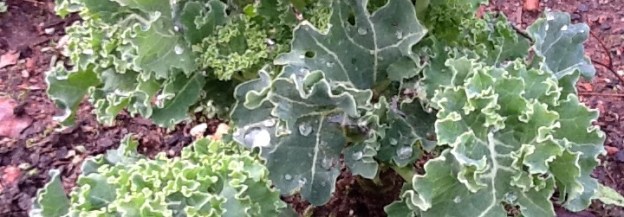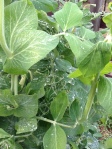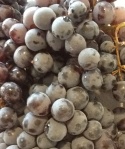It’s high season for kale and apples, and Katherine just can’t stop talking about epicuticular wax
There is something nostalgic about kale and its softly glowing dusky cast that suits late autumn and early winter. It looks rustic and thick-skinned, steeled against falling temperatures and short days. It even shrugs off winter rains. Water beads up and rolls right off its leaves. Kale’s ageless still-life look is due to its extraordinary epicuticular wax, a legacy of the first plants to survive on dry land.
Like all of us, plants have skin. Also like us, plants would lose water rapidly and disastrously through that skin if they didn’t secrete something greasy onto its epidermal surface. Whereas we are constantly pumping oil from our oil glands – sometimes too much, sometimes too little – plants maintain an intricate and precisely curated multilayered coating of wax.
The plant epidermis shouldn’t be confused with the thick skin of an apple. Fruit skins are multilayered and often colorful because they are filled with pigment bodies. The plant epidermis is a single layer of colorless cells, which let greens, reds, and purples show through from cells below. The epidermis includes various interesting cell types, which is a topic for another time. Its most important role in our current story is that it produces and secretes the components of the waxy cuticle, the most interesting layer of wax in the history of life on land.
Most people have encountered what we call a waxy cuticle on leafy greens or aquatic lotuses, although it is found on stems and leaves of nearly all plants living on land. (Some mosses and other bryophytes are exceptions.) Kale has an especially obvious cuticle. Fresh kale leaves are nearly impossible to wet, and blanching them in boiling water leaves a bathtub ring of wax behind on the pot. Fresh pea greens are another good example.
Apples and some other fruits have a fairly thick cuticle, much of which is removed when fruits are washed after harvest. Large commercial apple growers often replace the lost wax with food-grade wax to enhance shine and reduce water loss.
For a layer of wax, the cuticle is unusually interesting. It is not only a layer of wax, but a very thin layer of a soluble polymeric lipid called cutin, infused with wax and further covered by an elaborately sculptured layer of epicuticular wax. For plants, the cuticle is absolutely essential to surviving life on land. Fossilized remains of cuticles date back at least 400 million years (earlier dates remain controversial) and represent some of the earliest traces of land plants (Niklas, 1997). The cuticle covers above-ground portions of all vascular plants, and, like human skin, serves many varied purposes. Its most basic function is limiting water loss, but it also impedes the unregulated movement of carbon dioxide and oxygen into or out of the plant and the passage of air pollutants and volatile organic compounds into it. As demonstrated by kale leaves, epicuticular wax repels water, which otherwise could harbor undesirable bacteria and mold spores. It prevents dirt, microbes, and other particles from sticking, so that when water rolls off the plant, the water takes the dirt away with it (Riederer, 2006). This self-cleaning mechanism has been called the “lotus effect,” because lotus leaves (Nelumbo) use it to maintain their legendary reputation for purity. Obviously, many people would love to harvest the self-cleaning power of the cuticle and put it to use for all kinds of applications, and so they have. Engineers using biomimicry have developed paint and textiles that stay clean by repelling dirt and water (Barthlott and Neinhuis, 1997). We routinely harvest the wax layer to polish and protect our cars and furniture. For example, carnauba wax comes from the cuticle of the wax palm, Copernica cerifera (whose species name, cerifera, means “wax bearing”). Carnauba is also one of the more common food-grade waxes used to polish up those dewaxed apples.
Cuticle wax is not only useful, but delicately beautiful as well. The fine structure of the epicuticular surface wax can scatter or reflect light, putting the bloom on grapes and plums and giving a glaucous gray color to blue spruce and many succulents (Pfündel, 2006). By scattering light, the cuticle diverts some damaging UV radiation from the leaves. At the same time, the reflection of UV light from fruits may serve as an attracting signal to some fruit-dispersing animals that see UV wavelengths (Pfündel, 2006). The surface wax can also deter insects by making it hard for them to walk or lay eggs on leaves or stems. In some incredible cases, coevolution has worked on the waxes and the insect legs, such that only a plant’s symbiotic partner will be able to crawl along its surface (Müller, 2006). That’s another application many of us would love to adopt for ourselves.
Epicuticular wax comes in grains, rods, plates, and films. It may be amorphous, ridged, spiral, crenate, and spiked, crusty, greasy, and scaly. It occurs in loops, tubes, branches, and ribbons. The epicuticular wax is so ornate, and its form so often specific to a species or genus, that it is sometimes possible to identify a plant based on its wax layer alone (Riederer, 2006).
One of the most fascinating things about epicuticular wax is that it is so critical for plant function that it repairs itself, regenerating from scratch its rococo form. When something scratches the wax, or when a grower removes it in the course of cleaning fruit for market, the wax will grow back within a few days. You might ask why growers would replace lost apple wax with wax from another species if the apple epidermis will push out a new layer all by itself. It seems that a delay of even a few days will allow the fruit to dry out just a little bit, which cuts into sales. I’ll stick with my local apples, which are not denuded in the first place, and pretend that I can feel their curiously specific apple waxes on my tongue.
If the importance of the cuticle in the kitchen is not yet obvious, then a good vinaigrette on some fresh salad greens should help demonstrate. Thanks to the fat-loving waxy cuticle, all real salad dressings must include some oil if they are to stick to leafy greens. Whereas water beads up and rolls off an intact cuticle, oil does not, because it does not have water’s strong surface tension, and because it is chemically compatible with the lipid-based cuticle and its waxes. In an emulsified vinaigrette, the oil will surround droplets of water-based vinegar and hold them up against the leaves. However, dressed salads do not stay fresh-looking for long. Leaves in a tossed salad will inevitably have some flaws in their cuticles, and over time, some of the oil coating those leaves will be able to seep into the inner layers of the leaves, fill the air spaces, and cause the leaves to go limp and translucent (McGee, 1990). Damaged leaves also do not stay fresh very long, even in the refrigerator. Cracks in the cuticle allow naturally occurring bacteria and fungi to enter the leaf and feed on the broken cells inside.
Fortunately, kale does not go limp like some delicate summer salad. Now that it has stopped raining, I think I’ll go out and harvest a few of those steely leaves for dinner.
REFERENCES
Barthlott, W., and C. Neinhuis. 1997. Purity of the sacred lotus, or escape from contamination in biological surfaces. Planta 202: 1-8.
McGee, H. 1990. The Curious Cook: More kitchen science and lore. Hungry Minds, Inc, New York, NY.
Müller, C. 2006. Plant-insect interactions on cuticular surfaces. In Riederer, M. and C. Müller [ed.], Biology of the Plant Cuticle, Annual Plant Reviews vol. 23. Blackwell, Oxford UK.
Niklas, K. J. 1997. The Evolutionary Biology of Plants. University of Chicago Press, Chicago.
Pfündel, E. a. A., Giovanni and Cerovic, Zoran. 2006. Optical properties of plant surfaces. In Riederer, M. and C. Müller [ed.], Biology of the Plant Cuticle, Annual Plant Reviews vol. 23. Blackwell, Oxford, UK.
Riederer, M. 2006. Introduction: Biology of the Plant Cuticle. In Riederer, M. and C. Müller [ed.], Biology of the Plant Cuticle, Annual Plant Reviews vol. 23. Blackwell, Oxford UK.




This has become one of my very favorite blogs. I tried Valerian tea. I’m looking for mache seeds to try. I love kale, including the Italian kind, called there cavolo nero, but getting a different name here. I like kale straight, in salads, and perhaps best of all in a white bean soup with kale and a base of brewers yeast and onions fried in olive oil, perhaps from an ancient version of Tassahara Cookery. In St. Louis, I still have kale thriving in my garden, under plastic covered hoop row protectors.
LikeLike
Thanks for your comments, Joan. I love hearing about your soup and will definitely try adding a bit of brewers yeast to my white beans.
LikeLike
Pingback: Evolution of Lemon Flavor | The Botanist in the Kitchen
Pingback: Don’t Worry…Mother Nature’s Got This | HORTravels
Hello! Maybe you can help me. I picked some edible hibiscus recently and I left them in the sun in a Ziploc bag by accident. It produced this waxy fluid that I’m assuming is the epicuticular wax. I rubbed it in my hands and didn’t think anything of it. I realized shortly after my hands were soo soft. A day later they started peeling. Do you know anything about why this may be happening? Has these waxes on leaves been used for hands? Thank you in advance.
LikeLike
Carnauba wax is an epicuticular leaf wax from a palm. Some other common topical oils are pressed from fruit pulp (olive, avocado, sea buckthorn berry), but those fruits have fatty flesh, which yield the oil. Fatty fruit is unusual among plants, unlike epicuticular wax. All the other common body care oils I know of, though, are seed oils (these, for example). Hibiscus flowers are, of course, acidic, and organic acids can be skin softening, as well (look up lactic acid as a medicinal lotion ingredient, for example). I’d ascribe the reaction to the acid more than the wax, but, who knows! Maybe you’ve just landed on a magic new body care plant.
LikeLiked by 1 person
Yes, I agree with Jeanne that it’s likely that something non-waxy caused the peeling. Flowers have less wax than leaves, so although the liquid may have had some wax, it probably didn’t have a lot. Organic acids cause softening and peeling (which is why lactic acid is recommended as a mild exfoliant for some conditions).
LikeLiked by 1 person
thank you ladies
LikeLike
Pingback: Botany word of the month. – Flowery Prose